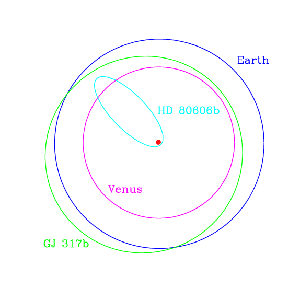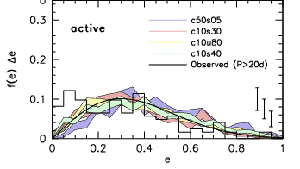 |
|
Fig. 1:
Orbits of Earth, Venus, and the extrasolar planets GJ 317b (green) and
HD 80606b (light blue). The red dot at the center marks the location
of the host star (the Sun or GJ 317); the dot is much larger than the
actual size of the star. The orbits of both extrasolar planets are
much more elongated than the orbits of Earth and Venus.
|
 |
 |
|
Fig. 2:
The distribution of orbital eccentricities for the known extrasolar
planets is shown as the black histogram. Circular orbits have zero
eccentricity, extremely elongated orbits have eccentricity of 1, and
GJ 317b has an eccentricity of 0.19. The colored bands show the
eccentricity distributions of the simulations, which match the
observations except for an excess of observed systems with
eccentricity less than 0.1, which probably represent systems like the
solar system in which a late stage of dynamical evolution has not
occurred.
|
|  |
Our understanding of the origins and distribution of planets like the
Earth has been revolutionized in the last decade or so by the
discovery of over 300 planets orbiting other stars. These planetary
systems differ in fundamental ways from our own solar system, and
thus show that the diversity of possible planetary systems is
much greater than most astronomers had suspected.
One of the most important of these differences is in the shapes of the
orbits. The orbits of most planets in the solar system are very nearly
circular; for example, the distance of the Earth from the Sun varies
by only 3% as it travels around its orbit. Mathematically, the shape
of an orbit is described by its eccentricity, which ranges from zero
for a circular orbit such as the Earth's to nearly unity for extremely
elongated orbits like those of some comets.
One of the most remarkable properties of the planets that have been
discovered around other stars is that their orbits are much more
elongated than the orbits of planets in the solar system. Figure 1
shows the orbits of two of these planets compared to Earth and Venus;
the planet in green is GJ 317b, which has a typical eccentricity, and
the planet in light blue, HD 80606b, has the largest known
eccentricity of any planet. These elongated shapes are surprising
since planets are believed to have condensed out of a circular disk of
gas and dust orbiting the host star (a concept originally suggested by
the Prussian philosopher Immanuel Kant in 1755), and so the orbit of a
planet should be circular, like that of the gas from which it formed.
Researchers Scott Tremaine (MPA and Institute for Advanced Study) and
Mario Juric (Princeton University) explored the possibility that
planetary orbits acquire their shapes after the process of planet
formation is complete and the gas disk has dissipated. In this
hypothesis, planets form on circular orbits but then the small,
regular gravitational tugs that they exert on one another as they
travel around their orbits gradually make the orbits more and more
elongated. In some cases this process leads to collisions of planets,
ejection of planets into interstellar space, or incineration of
planets by the star, while in others some or all of the planets
survive but on orbits with substantial eccentricities.
To test this hypothesis, Juric and Tremaine constructed several
thousand models of planetary systems, containing multiple planets on
nearly circular orbits around their host stars, and followed the
evolution of these orbits numerically for 100 million years. They
found that in a remarkably large fraction of these model systems, the
distribution of orbit shapes or eccentricities of the surviving
planets matched the distribution of eccentricities in the known
extrasolar planetary systems (see Figure 2). Other properties of the
model systems, such as the spacings of the planets, also matched the
observations well.
These findings imply that, although giant planets like Jupiter and
most of the known extrasolar planets were formed within the first
million years after the birth of their host stars, some of the
properties of planetary systems are determined much later, in a long,
slow phase of dynamical evolution lasting about 100 times longer.
Their research also suggests that the orbits of the planets in the
solar system are nearly circular because the planets were too widely
spaced, or of too low mass, to excite significant eccentricities. They
do not address the tantalizing question of why humans find themselves
in such an unusual planetary system. One obvious speculation is that
climatic conditions are inhospitable to life if the planetary orbits
are too eccentric.
Scott Tremaine
Publications
M. Juric and S. Tremaine,
"Dynamical origin of extrasolar planet eccentricity distribution ",
2008,
 Astrophysical Journal
(to be published) Astrophysical Journal
(to be published)
|



